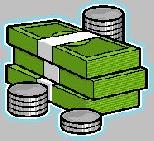
 |
|
| Financial Terms | |
| Turnover |
|
Information about financial, finance, business, accounting, payroll, inventory, investment, money, inventory control, stock trading, financial advisor, tax advisor, credit.
Main Page: inventory, inventory control, money, tax advisor, finance, credit, business, payroll, |
Definition of Turnover
TurnoverMutual Funds: A measure of trading activity during the previous year, expressed as a percentage of TurnoverThe business income or sales of goods and services.
Related Terms:Accounts receivable turnoverThe ratio of net credit sales to average accounts receivable, a measure of how Asset turnoverThe ratio of net sales to total assets. Fixed asset turnover ratioThe ratio of sales to fixed assets. Inventory turnoverThe ratio of annual sales to average inventory which measures the speed that inventory Portfolio turnover rateFor an investment company, an annualized rate found by dividing the lesser of Receivables turnover ratioTotal operating revenues divided by average receivables. Used to measure how  Total asset turnoverThe ratio of net sales to total assets. INVENTORY TURNOVERThe number of times a company sold out and replaced its average stock of goods in a year. The formula is: accounts receivable turnover ratioA ratio computed by dividing annual asset turnover ratioA broad-gauge ratio computed by dividing annual inventory turnover ratioThe cost-of-goods-sold expense for a given Fixed Assets Turnover RatioA measure of the utilization of a company's fixed assets to Inventory Turnover RatioProvides a measure of how often a company's inventory is sold or Total Asset Turnover RatioA measure of the utilization of all of a company's assets to asset turnovera ratio measuring asset productivity and showing the number of sales dollars generated by each dollar of assets  Inventory turnoverThe number of times per year that an entire inventory or a Cash TurnoverThe number of cash cycles completed in one year. Inventory TurnoverRatio of annual sales to inventory, which shows how many times the inventory of a firm is sold and replaced during an accounting period. Dupont system of financial controlHighlights the fact that return on assets (ROA) can be expressed in terms Short-term solvency ratiosRatios used to judge the adequacy of liquid assets for meeting short-term Total revenueTotal sales and other revenue for the period shown. Known as "turnover" in the UK. Du Pontmodel a model that indicates the return on investment Slow-moving itemAn inventory item having a slower rate of turnover than the Related to : financial, finance, business, accounting, payroll, inventory, investment, money, inventory control, stock trading, financial advisor, tax advisor, credit. |